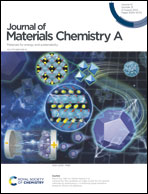Symmetry breaking in Ge1−xMnxTe and the impact on thermoelectric transport†
Abstract
Germanium telluride is a high performing thermoelectric material that additionally serves as a base for alloys such as GeTe–AgSbTe2 and GeTe–PbTe. Such performance motivates exploration of other GeTe alloys in order understand the impact of site substitution on electron and phonon transport. In this work, we consider the root causes of the high thermoelectric performance material Ge1−xMnxTe. Along this alloy line, the crystal structure, electronic band structure, and electron and phonon scattering all depend heavily on the Mn content. Structural analysis of special quasirandom alloy structures indicate the thermodynamic stability of the rock salt phase over the rhombohedral phase with increased Mn incorporation. Effective band structure calculations indicate band convergence, the emergence of new valence band maxima, and strong smearing at the band edge with increased Mn content in both phases. High temperature measurements on bulk polycrystalline samples show a reduction in hole mobility and a dramatic increase in effective mass with respect to increasing Mn content. In contrast, synthesis as a function of tellurium chemical potential does not significantly impact electronic properties. Thermal conductivity shows a minimum near the rhombohedral to cubic phase transition, while the MnGe point defect scattering is weak as indicated by the low KL dependence on the Ge–Mn fraction (



 Please wait while we load your content...
Please wait while we load your content...